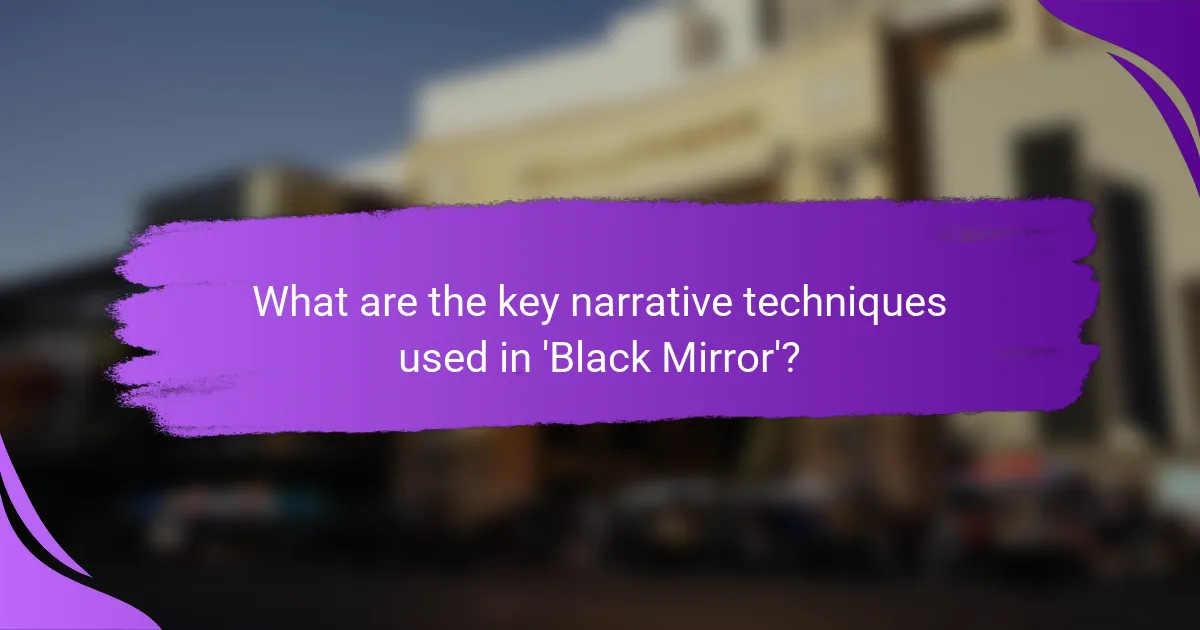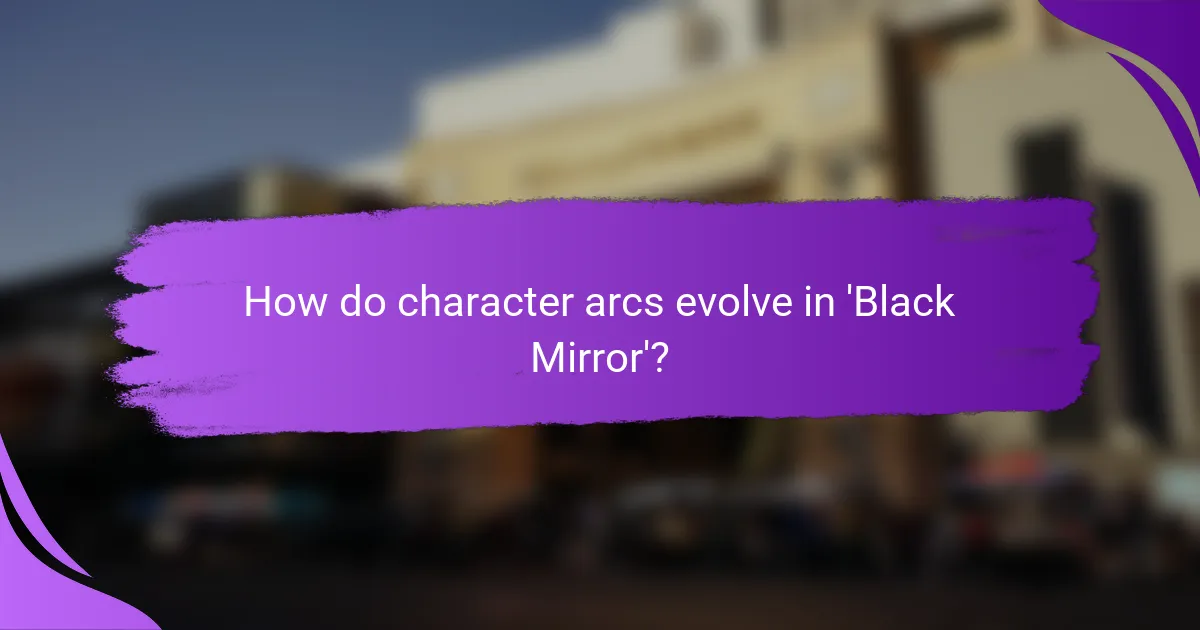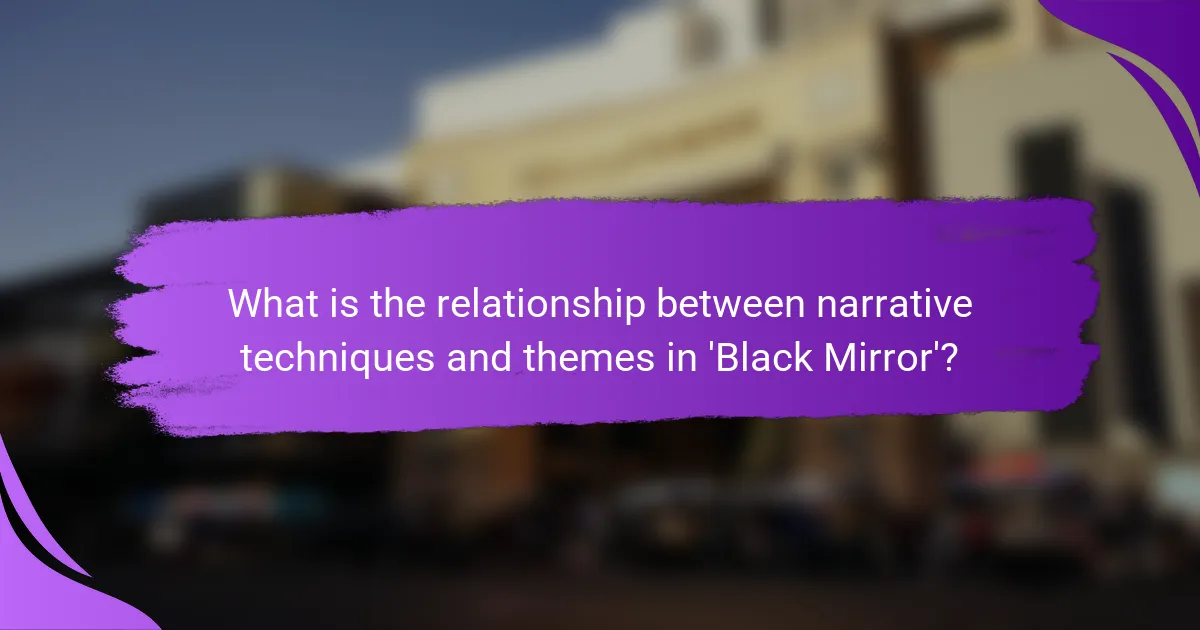The article explores the narrative techniques used in the television series ‘Black Mirror,’ focusing on anthology storytelling, nonlinear timelines, and social commentary. It highlights how anthology storytelling allows for diverse themes and character explorations, while nonlinear timelines create suspense and engagement through unexpected twists. The piece also examines the evolution of character arcs, which are shaped by intense personal dilemmas and ethical conflicts, often leading to moral or existential crises. Additionally, the relationship between narrative techniques and themes is analyzed, emphasizing how these elements deepen the show’s exploration of technology’s impact on society and human morality. Overall, the article provides a comprehensive analysis of how narrative choices enhance the thematic depth of ‘Black Mirror.’

What are the key narrative techniques used in ‘Black Mirror’?
The key narrative techniques used in ‘Black Mirror’ include anthology storytelling, nonlinear timelines, and social commentary. Anthology storytelling allows each episode to explore different themes and characters. This technique enables unique narratives that reflect various aspects of society. Nonlinear timelines create suspense and engage viewers through unexpected twists. This approach often reveals crucial information at pivotal moments. Social commentary serves as a cornerstone of the series. It critiques contemporary issues, such as technology’s impact on human relationships. The combination of these techniques enhances the show’s depth and relevance. Each episode stands alone yet contributes to a broader discourse on modern life.
How do these techniques enhance storytelling in ‘Black Mirror’?
Narrative techniques in ‘Black Mirror’ enhance storytelling by creating immersive and thought-provoking experiences. The use of non-linear narratives allows for complex character development and thematic exploration. Each episode often features a twist that challenges viewers’ perceptions of technology and morality. This unpredictability keeps audiences engaged and prompts critical thinking. Additionally, the anthology format enables diverse storytelling, showcasing various societal issues. Themes of dystopia and human interaction with technology resonate throughout the series. These elements collectively deepen the emotional impact and relevance of the stories. The intricate weaving of themes and character arcs exemplifies the show’s innovative narrative style.
What role does non-linear storytelling play in character development?
Non-linear storytelling enhances character development by revealing backstory and motivations in a non-sequential manner. This technique allows viewers to understand characters through fragmented perspectives. It creates suspense and encourages audience engagement as they piece together the narrative. In ‘Black Mirror,’ non-linear structures often highlight the consequences of technology on personal relationships. For example, in “The Entire History of You,” the non-linear format reveals the protagonist’s insecurities and jealousy gradually. This approach deepens emotional resonance and complexity in character arcs. By juxtaposing past and present, non-linear storytelling illuminates character growth or decline effectively.
How does the use of irony shape viewer perception?
The use of irony significantly shapes viewer perception by creating a contrast between expectation and reality. This technique often leads viewers to question the authenticity of characters and their motivations. In ‘Black Mirror’, irony is employed to highlight societal flaws and technological consequences. For instance, an episode may present a seemingly utopian scenario that ultimately reveals dystopian truths. This dissonance engages viewers more deeply, prompting critical reflection on the narrative. Research indicates that irony enhances emotional engagement and cognitive processing in audiences. Studies show that viewers are more likely to remember ironic moments due to their unexpected nature. Thus, irony serves as a powerful narrative tool in shaping how audiences interpret and respond to the story.
What themes are prevalent throughout ‘Black Mirror’?
‘Black Mirror’ explores several prevalent themes, including technology’s impact on society, dystopia, and human relationships. The series critiques modern society’s reliance on technology. Episodes often depict how advancements lead to unintended consequences. Dystopian settings highlight societal fears regarding surveillance and loss of privacy. Human relationships are examined through the lens of technology’s influence. Characters often face moral dilemmas related to their choices and technology’s role in their lives. The show serves as a cautionary tale about potential futures shaped by current trends. Each episode presents a unique narrative that reinforces these themes.
How does technology influence human relationships in the series?
Technology significantly influences human relationships in ‘Black Mirror’ by amplifying emotional distances and altering communication dynamics. The series often portrays characters who become isolated due to their dependence on technology. For instance, in “Nosedive,” social media ratings dictate personal interactions, leading to superficial relationships. In “Be Right Back,” a character uses technology to recreate her deceased partner, which complicates her grief and connection. These narratives illustrate how technology can distort genuine human connections. The series showcases the consequences of technology on empathy, trust, and intimacy among individuals.
What societal issues are reflected through the show’s narratives?
‘Black Mirror’ reflects various societal issues, including technology’s impact on relationships, privacy concerns, and mental health. The show critiques how technology can isolate individuals and distort human connections. Episodes often highlight the dangers of surveillance and data misuse, showcasing a loss of privacy. Mental health themes emerge through characters experiencing anxiety and depression due to technological pressures. The narratives also explore ethical dilemmas in artificial intelligence and virtual realities. Each episode serves as a cautionary tale about potential futures shaped by current societal trends. The series prompts viewers to question their relationship with technology and its implications for society.

How do character arcs evolve in ‘Black Mirror’?
Character arcs in ‘Black Mirror’ evolve through intense personal dilemmas and ethical conflicts. Each episode typically presents a protagonist facing a technological or societal challenge. These challenges force characters to confront their values and decisions. As the narrative unfolds, characters often experience significant transformations. The evolution frequently leads to a moral or existential crisis. In many cases, the arcs culminate in a poignant or unsettling resolution. This structure highlights the consequences of human choices in a tech-driven world. The show’s anthology format allows for diverse character explorations across different episodes.
What makes character development unique in ‘Black Mirror’?
Character development in ‘Black Mirror’ is unique due to its focus on moral dilemmas and technological consequences. Each episode features distinct characters facing extreme situations. These characters often undergo rapid transformations influenced by technology. The narrative structure allows for exploration of their psychological depths. This creates a sense of realism despite the speculative context. Additionally, characters frequently experience ambiguous endings, enhancing their complexity. The anthology format enables diverse character experiences across episodes. This variety highlights different facets of human nature in relation to technology.
How do individual episodes showcase different character transformations?
Individual episodes of ‘Black Mirror’ illustrate distinct character transformations through their unique narratives. Each episode presents a self-contained story, allowing characters to evolve in response to specific technological or societal challenges. For instance, in “Nosedive,” the protagonist undergoes a significant transformation from a status-driven individual to someone who rejects societal validation. This shift highlights the dangers of prioritizing social media over genuine human connections. In “San Junipero,” characters experience profound changes as they navigate love and mortality in a digital afterlife. Their transformations emphasize themes of choice and the human experience. These episodes effectively use technology as a catalyst for character development, showcasing how external pressures influence personal growth.
What is the significance of flawed characters in the narrative?
Flawed characters are significant in narratives as they create depth and relatability. Their imperfections mirror real human experiences, enhancing emotional engagement. In ‘Black Mirror’, flawed characters often face moral dilemmas that provoke critical thinking. For example, characters like Lacie in “Nosedive” illustrate the consequences of societal pressures on personal identity. This complexity allows audiences to explore themes of technology and morality. Flawed characters also drive the plot forward through their struggles, leading to transformative arcs. Their conflicts can reveal societal flaws, prompting reflection and discussion among viewers. Overall, flawed characters enrich narratives by fostering connection and challenging perceptions.
How do the characters’ choices impact the overall themes?
Characters’ choices significantly shape the overall themes in ‘Black Mirror.’ Their decisions often reflect moral dilemmas and societal critiques. For instance, in “Nosedive,” Lacie’s pursuit of social validation leads to her downfall. This illustrates the theme of superficiality in social media culture. Similarly, in “San Junipero,” the choices made by Yorkie and Kelly explore themes of love and the value of life experiences. Their decisions highlight the conflict between reality and virtual existence. Each character’s choice serves to reinforce the narrative’s thematic exploration of technology’s impact on human relationships and identity.
What examples illustrate the consequences of technology on personal decisions?
In “Black Mirror,” technology significantly impacts personal decisions, often leading to unintended consequences. For instance, in the episode “Nosedive,” characters are driven by social media ratings. Their self-worth and personal choices hinge on public approval, illustrating technology’s power over individual behavior. Another example is “Fifteen Million Merits,” where characters must earn merits to escape a monotonous existence. This reliance on technology for validation shapes their life choices and aspirations. Additionally, “White Christmas” explores how technology can manipulate memories, affecting relationships and ethical decisions. These examples highlight technology’s profound influence on personal decision-making and its potential to distort reality.
How do characters serve as reflections of societal fears?
Characters serve as reflections of societal fears by embodying anxieties prevalent in contemporary culture. In ‘Black Mirror’, characters often represent issues like technology addiction, surveillance, and loss of privacy. These portrayals resonate with viewers, highlighting their own fears about the future. For example, in the episode “Nosedive,” the character Lacie struggles with social media validation. This reflects societal concerns about self-worth tied to online presence. Similarly, in “Fifteen Million Merits,” the protagonist’s plight illustrates fears around consumerism and exploitation. These narratives provoke critical discussions about real-world implications. Thus, characters in ‘Black Mirror’ effectively mirror and amplify societal fears, prompting deeper reflection and awareness.

What is the relationship between narrative techniques and themes in ‘Black Mirror’?
The relationship between narrative techniques and themes in ‘Black Mirror’ is intricate and significant. The series employs various narrative techniques, such as non-linear storytelling and anthology format. These techniques enhance the exploration of complex themes like technology’s impact on society and human morality. Each episode presents a unique story, allowing for diverse thematic interpretations. For instance, the use of dark humor juxtaposes with serious social commentary. This contrast deepens the audience’s engagement with the themes. Additionally, character arcs often reflect the consequences of technological advancements. The narrative choices amplify the emotional resonance of these themes, making them more impactful. Overall, narrative techniques serve to underline and enrich the thematic elements in ‘Black Mirror’.
How do narrative structures support thematic exploration?
Narrative structures support thematic exploration by organizing the plot and character development in a way that highlights key ideas. They provide frameworks that guide the audience’s understanding of complex themes. For example, non-linear storytelling in ‘Black Mirror’ allows for the juxtaposition of different timelines. This technique emphasizes the consequences of technology on human relationships. Additionally, episodic narratives enable standalone stories that each tackle distinct themes. Each episode can explore a unique aspect of societal issues, such as privacy or morality. The use of irony in narrative structures further deepens thematic resonance. Irony often reveals contradictions in human behavior and societal norms. Overall, narrative structures are essential for effectively conveying and enhancing thematic depth.
What are the connections between plot twists and thematic revelations?
Plot twists and thematic revelations are interconnected elements in storytelling. Plot twists often serve to challenge the audience’s expectations. They can reveal deeper truths about characters or society. This revelation enhances the thematic depth of a narrative. For instance, a sudden plot twist may expose a character’s hidden motives. This can lead to a greater understanding of themes like betrayal or morality. In ‘Black Mirror’, plot twists frequently highlight societal critiques. They force viewers to reconsider their assumptions about technology and human behavior. This connection enriches the viewer’s experience and prompts reflection on the underlying themes.
How does the pacing of episodes affect thematic development?
The pacing of episodes significantly influences thematic development in storytelling. Rapid pacing can create urgency, emphasizing themes such as technology’s impact on society. Conversely, slower pacing allows for deeper character exploration and nuanced thematic engagement. For example, in ‘Black Mirror’, episodes with quick transitions often highlight the consequences of technological advancements. In contrast, episodes that unfold gradually encourage viewers to reflect on moral dilemmas. This variance in pacing directly shapes how themes resonate with the audience. Studies show that audience engagement correlates with pacing; faster pacing can lead to heightened emotional responses. Therefore, pacing serves as a crucial narrative technique in developing themes effectively.
What can viewers learn from ‘Black Mirror’s’ narrative style?
Viewers can learn about the impact of technology on society through ‘Black Mirror’s’ narrative style. The series employs a dystopian lens to explore contemporary issues. Each episode serves as a cautionary tale that reflects real-world concerns. Characters often face moral dilemmas influenced by technological advancements. The storytelling structure creates a sense of unease and provokes critical thinking. Viewers are encouraged to question their relationship with technology. The narrative style emphasizes the consequences of human behavior in a tech-driven world. Overall, ‘Black Mirror’ illustrates the complexities of modern life through engaging and thought-provoking narratives.
How can narrative techniques be applied to other storytelling mediums?
Narrative techniques can be applied to other storytelling mediums by adapting their structures and devices. For instance, visual storytelling in film can utilize flashbacks to create suspense, similar to techniques used in literature. Additionally, interactive mediums, like video games, can employ branching narratives to enhance player engagement, akin to character-driven arcs in television. Graphic novels can merge dialogue and imagery to convey complex emotions, reflecting narrative depth found in traditional prose. These adaptations demonstrate how core narrative elements can transcend their original formats, enriching the audience’s experience across various platforms.
What best practices can writers adopt from ‘Black Mirror’?
Writers can adopt several best practices from ‘Black Mirror’. One key practice is to explore contemporary societal issues through speculative fiction. ‘Black Mirror’ often reflects real-world anxieties about technology and human behavior. Another practice is to craft self-contained narratives that provoke thought. Each episode stands alone, allowing for diverse themes and tones. Writers should also focus on character development that reveals moral dilemmas. Characters often face difficult choices that resonate with viewers. Additionally, creating unexpected twists can enhance engagement. ‘Black Mirror’ frequently subverts expectations, leaving audiences in contemplation. Lastly, employing a darkly satirical tone can effectively critique societal norms. This approach makes the commentary both entertaining and impactful.
The main entity of the article is ‘Black Mirror,’ a television series known for its exploration of contemporary societal issues through unique narrative techniques. The article examines key storytelling methods such as anthology format, non-linear timelines, and the use of irony, highlighting how these techniques enhance character development and thematic depth. It discusses prevalent themes including technology’s impact on human relationships, dystopia, and moral dilemmas faced by characters. Additionally, the article analyzes how character arcs evolve in response to technological challenges, reflecting societal fears and prompting critical reflection among viewers. Overall, the article provides a comprehensive overview of how narrative techniques in ‘Black Mirror’ shape its exploration of complex themes and character transformations.